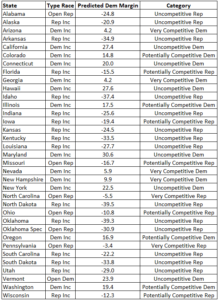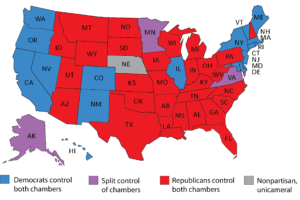In ‘know your adversary’ news, Matthew Sheffield reports in his Flux article that, “For decades, Republican consultants spent big to promote leftist candidates, now they’ve started creating fake ones: Instead of trying to build a majority, the American right has decided to divide and conquer.” Sheffield documents the sleazy history of GOP fronting fake and unelectable Democratic candidates, and writes, “It’s not currently known how large the GOP effort to put forward sham candidates in 2020 was, but the evidence from Florida and other states suggests that it is becoming an increasingly common tactic. A fourth ringer “independent” candidate, Leroy Sanchez, who ran in Florida’s House District 42 has been connected with the Senate candidate ring through a Republican lobbyist named Macy Harper. Sanchez, who is the brother of a top Florida Republican donor, received just under 7,500 votes for his non-candidacy, far greater than the 1,160 margin that enabled the GOP candidate in the race to win.” It appears Republican operatives are particularly interested in fronting g pro-weed candidates to siphon votes away from Democrats. As Sheffield writes, “Minnesota Republicans also tried the fake candidate tactic in 2020, according to Adam Weeks, a man who ran on the Legal Marijuana Now Party line. Shortly before he died in the September before the election, Weeks left a voicemail for a friend which said that he had been recruited to siphon away votes from Angie Craig, the Democratic candidate in the state’s 2nd U.S. House district. Despite his death, Weeks remained on the ballot and received nearly 25,000 votes. That was not enough to block Craig, but it made the race significantly closer than it would have been….Weeks was far from the only person apparently recruited by Minnesota Republicans to run on a pro-weed candidacy. In May of last year, Kevin Ne Se Shores, a blind and disabled veteran who ran in 2020 as a candidate on the Grassroots Legalize Cannabis Party line in the state’s 7th U.S. House district, said that he had been recruited to run by Kip Christianson, an employee of the Republican National Committee at the time. Shores said that Christianson paid his $300 filing fee, in addition to helping him get into the pot party’s primary election.” But in light of Republicans’ increasing reliance on fake candidates and their long history of trying to manipulate Black Americans and other progressive voters, electoral reforms are necessary.”
However, Charlie Cook explains why “Even in a Great Year, Republicans’ Winnable Seats Are Limited,” and observes at The Cook Political Report that “after three consecutive cycles of very aggressive, even audacious gerrymandering by both parties, the number of competitive districts is much smaller, arguably reducing the volatility….Another reason is that Democrats lost a dozen House seats in 2020. Just as the ‘A’ seat on an airliner is always a window seat, a party cannot lose a seat they don’t have….In modern times, big wave elections have tended to come from a party well behind in seats. Republicans’ House gain of 54 seats in 1994 was from a starting point of just 174 seats; their 64-seat pickup in 2010 was from 178 seats. When Democrats gained 42 seats from Republicans in 2018, they started with just 194 seats. Allocating the currently vacant seats into the column they had come from (and will likely return), Democrats hold 222 seats and Republicans 213, well above the GOP levels going into 1994 and 2010 and Democrats in 2006….Most current estimates of likely GOP House gains range from as low as a dozen seats (seven more than necessary for the barest majority) to about three dozen. The current outlook from David Wasserman, The Cook Political Report with Amy Walter’s expert on the House, is a Republican gain of between 20 and 35 seats….Then again, caution may be in order in applying historic patterns from a period before partisan polarization became as extreme as it is today, with defections among partisans quite rare and pure independents exceedingly fickle and prone to buyer’s remorse.”
Li Zhou reports on the “House Democrats’ sweeping gun control package” at Vox, and notes: “Although lawmakers are currently on recess, the House Judiciary Committee returned Thursday for an urgent session focused on multiple bills intended to address the age limit for purchasing guns, the sale of large-capacity magazines, and firearm storage. During the markup, committee members approved the package, setting it up for a floor vote as soon as next week….This legislation — which will inevitably be blocked in the Senate — is an acknowledgment of the importance of this issue, and a way for Democrats to show voters that they are trying to take action in the wake of recent mass shootings in Buffalo, New York, Uvalde, Texas, and Tulsa, Oklahoma….As part of this week’s meeting, Democrats considered eight bills, which they’ve dubbed the Protect Our Kids Package. This legislation is in addition to votes the House will take on a federal red-flag law sponsored by Rep. Lucy McBath (D-GA), which enables law enforcement to confiscate weapons from an individual who’s seen as a threat to themselves or others, as well as a markup it will conduct on an assault weapons ban. House Democrats also previously voted on two bills that would strengthen background checks for guns….The House actions are occurring in parallel with bipartisan talks in the Senate that are expected to result in a much narrower bill, if any at all. Earlier this week, Sens. John Cornyn (R-TX), Chris Murphy (D-CT), Thom Tillis (R-NC), and Kyrsten Sinema (D-AZ) met via Zoom to continue discussions about a possible deal that’s likely to center on “red flag laws” or background checks.” Many Democrats worry, based on previous experience, that the Republicans are running another ‘Lucy holding the football’ scam. But running out the clock may not work this time, since mass shootings are increasing alarmingly. No matter what happens with the senate negotiations, good on House Dems for at least setting a high standard.
In her article, “These Data Nerds Think They’ve Found the Climate Silver Bullet: Nonvoting Environmentalists: The Environmental Voter Project wants to turn infrequent voters who care about the environment into a force that can swing elections” at The New Republic, Lisa Featherstone writes, “Voters don’t care enough about climate, according to conventional wisdom. The best way to address climate change is for Democrats to win elections by talking about other subjects, consultants say. The problem with this political advice is that Democratic politicians, acting on the insight that voters don’t care, get into office and then don’t set a high priority on climate policy—because they want to be reelected….Put this way, it sounds like we have an almost unsolvable problem on our hands, one that could lead us to believe that representative democracy was incompatible with human survival. Conversations with liberals and progressives these days, especially those engaged in climate issues, are unfailingly gloomy. The right seems to be on a winning streak; relatedly, we’re all doomed. But what if there was a way out of this existential cul-de-sac?…The data nerds and activists behind the Environmental Voter Project, or EVP, think there is. They’ve got extensive research and proven results to support this crazy bit of optimism, and they’re using it to try to sway the midterms, a looming political event that most liberals are hailing with unqualified despair….The big surprise of EVP’s research is that far more nonvoters list climate as their top priority. And what that means, Stinnett says, is that turning nonvoting environmentalists (and “drop off” voters, those who have voted in presidential years but not otherwise) into voters could swing elections….Lots of environmentalists don’t need their minds changed. They need a behavioral change.” These people don’t need to be told to care about the environment. They need to be organized into voting….This year, EVP argues that “drop off” environmental voters alone could easily swing the midterms in Arizona, North Carolina, Nevada, and New Hampshire; the number of drop-off voters in each of those states far surpasses the margins of victory in the 2018 midterms and, in Pennsylvania, in the 2020 presidential race.” Read Featherstone’s article for more insights into how Dems can mine this vein.





